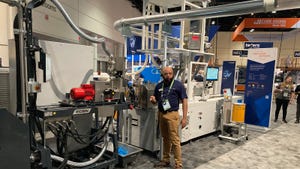Global Plastics Summit: Polycarbonate capacity surge may soften pricing
Chicago: The global polycarbonate market is growing 3.2% this year and total demand is expected to reach 3.7 million metric tons, according to David Gee, senior principal analyst at IHS, who spoke at the first annual Global Plastic Summit jointly sponsored by IHS and SPI, the Plastics Industry Trade Organization.
November 8, 2013

, the Plastics Industry Trade Organization. Capacity will be growing above 5% over the next five years, creating opportunities for buyers to negotiate price reductions.
It was clear from Gee's presentation that polycarbonate--which was discovered and largely developed at labs in Pittsfield, MA and Leverkusen, Germany--is now very much driven by developments in China. "All roads for polycarbonate are going to lead to China," Gee said.
Asia now represents 59% of total demand. The United States is just 14%. Five new polycarbonate plants are being built in China and one in Korea.
Bayer MaterialScience is building a 300,000 metric tons plant in near Shanghai;
Sinopec/SABIC, 130,000 metric tons in Tianjin, China;
Ocean King, 100,000 metric tons in Ningbo, Zhejiang, China;
LingYou Engineering Plastics, 80,000 metric tons in Shanghai;
Cheil, 80,000 metric tons in Yeosu, Korea; and
Lihuayi Group, 60,000 metric tons in Shandong, China.
"There is a lot of new capacity coming on, something in excess of 900,000 metric tons," Gee said at the conference. The new capacity comes on top of a SABIC polycarbonate expansion in Saudi Arabia in 2011.
"Global operating rates are expected to be in the 70s, possibly high 70s, and this could be very problematic for a lot of the producers of polycarbonate. We feel this would lead to some deferrals of some of the projects, which we have already started to see."
Polycarbonate costs are driven by phenol, a precursor chemical used to make bisphenol A, a primary component of the engineering plastic. Other chemical components include chlorine, caustic soda and carbon monoxide. Phenol, which is made from benzene, was above 80 cents per pound at the beginning of the year. Polycarbonate producers tried to boost prices, but failed as phenol tags dropped about 10 cents per pound through the year.
IHS projects that phenol prices will drop very slightly through next summer, and then rise slightly. Polycarbonate prices are expected to stay around $1.50 a pound in the next few months, with some opportunities to negotiate as new capacity comes on stream. "Margin improvement will be a challenge for producers," Gee said.
The biggest markets for polycarbonate are electrical/electronics, 21%; sheet/film, 19%; optical media, 14%; and automotive (non-window), 13%.
The medical and eyewear segment only represents 3% of global demand, but it's a high-value market for producers. It's a segment that will be under pressure, according to Paul Blanchard, director of engineering plastics at IHS. Responding to a question, Blanchard said that polycarbonates were not designed for the high heat of sterilization processes, leading to potential problems with BPA release. Poor chemical resistance has also been an issue for polycarbonate in medical applications, prompting development of new specialty grades.
You May Also Like

